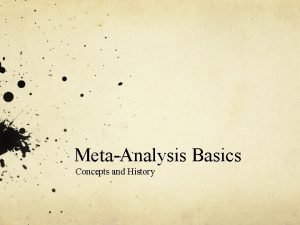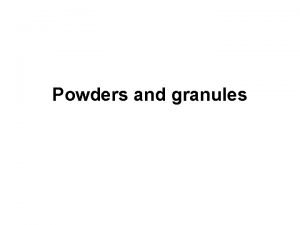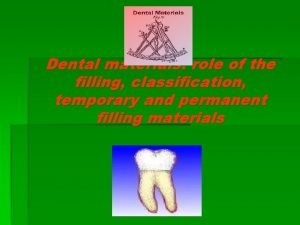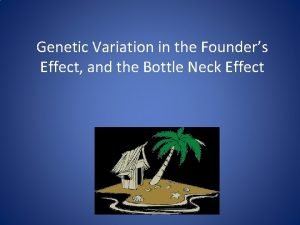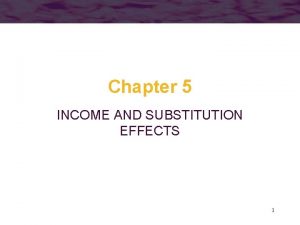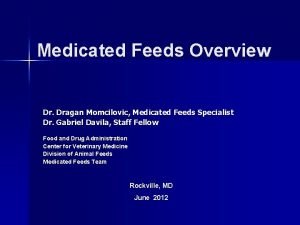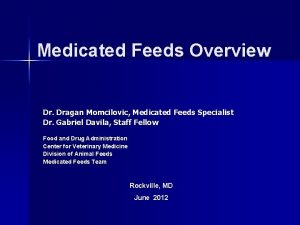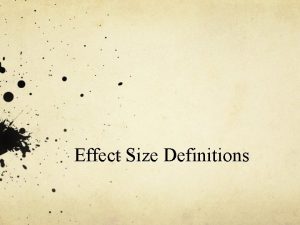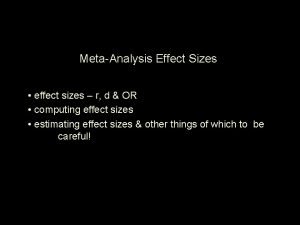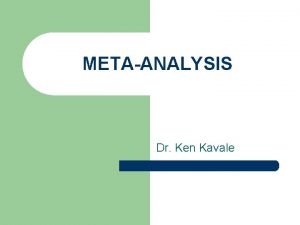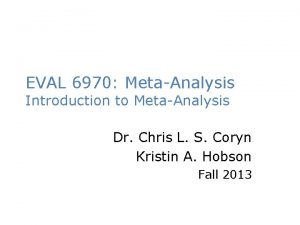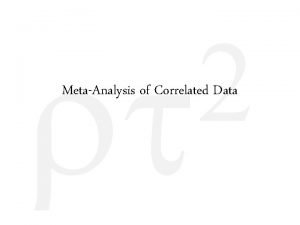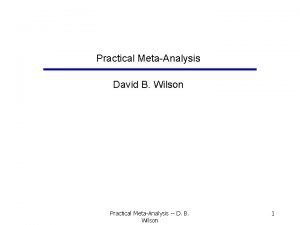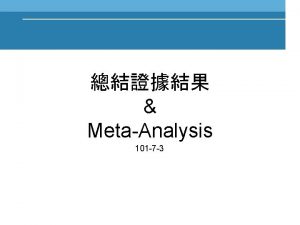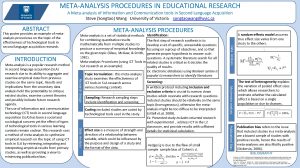A METAANALYSIS OF THE EFFECT OF MEDICATED HEALTH

















- Slides: 17

A META-ANALYSIS OF THE EFFECT OF MEDICATED HEALTH COMMUNICATION CAMPAIGNS TRENT C. JOSEPH PCH 586

WHAT IS META-ANALYSIS? -Statistical procedure for combining data from independent studies. -Used to determine the effectiveness of a study by using a common measure called effect size. -Successful meta-analysis can be used to identify the reason for the variation of effect.

BIOSTAT 101: EFFECT SIZE • Effect size is a simple way of quantifying the difference between two groups. *valuable for quantifying effectiveness of a particular intervention • “Does it work or not? ” vs. “How well does it work in a range of contexts? ” • Important tool for reporting and interpreting effectiveness than statistical significance (p-value).

THE CURRENT STUDY -Snyder et al. (2004) performed a meta-analysis of studies of mediated health campaigns in the United States. Purpose: To estimate the average effects of medicated health campaigns for different health topics and types of behavior. Research Questions: 1. What is the average effect size for different campaign topics? 2. Which function best describes the impact of baseline behavior rates on campaign effect size?

VARIABLES Independent Variable(s): Campaign Topic Type of Behavior Adoption Type Addictiveness of Behavior Baseline Behavior Rate Dependent Variable(s): Effect on behavior change

HYPOTHESES 1. Campaigns promoting the commencement of a new behavior will have a greater average effect size than campaigns promoting the prevention of an undesirable behavior, which in turn, will have a greater average effect size than campaigns promoting the cessation of an existing undesirable behavior. 2. Campaigns that promote the cessation of addictive behaviors will have a smaller effect size than those promoting the cessation of non-addictive behaviors.

CAMPAIGN TOPIC/BEHAVIOR The broad categories of campaign topics included: • Smoking • Drinking • Seat-belt use • Cardiovascular (diet and exercise) • Mammography • Dental care • Sexual behavior Unfortunately, it is not feasible to meta-analyze the effects of mediated campaigns on most specific behaviors because there are few studies conducted on those specific behaviors.

ADOPTION TYPE • The “goal of the campaign” • However, it may be difficult to categorize that “goal” to only prevent a behavior without necessarily promoting a new behavior. A promising distinction is to differentiate between: (a)The commencement or a new behavior (b)The prevention of an undesirable new behavior (c)The cessation/reduction of an old behavior

WHAT ADOPTION TYPE DO THESE CAMPAIGNS HAVE? UK Campaign: http: //youtu. be/ymi. F-okrd. Mg Embrace Life Campaign: http: //youtu. be/h-8 PBx 7 iso. M Strong 4 Life Campaign: http: //youtu. be/HKz. Y 0 v. Xlhn. Q

ADDICTIVE BEHAVIOR Is the behavior addictive or not? • Campaigns should seek to alter an individual’s intentions and attitudes towards the behavior • Addiction increases resistance to campaign messages • There are often physiological barriers to changing an addictive behavior

BASELINE BEHAVIOR RATE -The pretest percentage of the desired behavior in the invention community. Diffusion Theory: the percentage of the population that adopts to a new behavior and follows a predictable pattern over time. Bandwagon effect: positive impact on baseline behavior rate. The more people who engage in the behavior the more correct the behavior appears to be. “Resistance effect”

MEASURES • To compute the effect size for each campaign researchers converted the published statistic into a correlation (r) using standard deviation formulas. • The correlation was then converted from r to d with the DSTAT. To calculate the d-statistic researchers used the following formula: Cohen’s D

KEY FINDINGS • The average media campaign effect on behavior was r=. 09. Cohen's d 0. 2 0. 5 0. 8 Interpretation Small meduim Large

FINDINGS CONT’D • Half (48) of the campaigns promoted the adoption of a new behavior and were more successful than prevention and cessation campaigns (r=. 12). • Smoking was the only addictive behavior represented in the campaigns making the test of H 1 weak. • Behavior rate results were inconclusive.

RECOMMENDATIONS • Campaign planners should set modest goals for campaigns and be sure to use large sample sizes to detect effect size. • It would also help to consider the type of behavior being promoted (CCP) and whether or not the campaign behavior is addictive. • To effectively test campaign effect size researchers' should design a field experiment to directly test novel campaign designs.

• It is essential to understand the key characteristics of campaigns that moderate effect size and it is critical to remember that small percentages may affect very large numbers of people. • For new campaign topics, it is important to know whether or not there will be enforcement messages since they have greater success rates. • Lastly, media campaigns may be more costeffective when compared to clinical-based education

REFERENCES Comprehensive meta-analysis. (2006). Retrieved from http: //www. metaanalysis. com/pages/why_do. html Communicate and Collaborate. (2009). http: //www. peersnet. com/General/12857
 What is metaanalysis
What is metaanalysis Comprehensive metaanalysis
Comprehensive metaanalysis Medicated evacuant enema definition
Medicated evacuant enema definition Granules dosage form
Granules dosage form Medicated elixirs examples
Medicated elixirs examples Monophasic and biphasic liquid dosage form
Monophasic and biphasic liquid dosage form Permanent medicated filling
Permanent medicated filling Scalp conditioner definition
Scalp conditioner definition Classification of obturation techniques
Classification of obturation techniques Different types of powders in pharmacy
Different types of powders in pharmacy Chloride shift
Chloride shift Bottleneck effect
Bottleneck effect Income effect formula
Income effect formula Hình ảnh bộ gõ cơ thể búng tay
Hình ảnh bộ gõ cơ thể búng tay Lp html
Lp html Bổ thể
Bổ thể Tỉ lệ cơ thể trẻ em
Tỉ lệ cơ thể trẻ em Voi kéo gỗ như thế nào
Voi kéo gỗ như thế nào
